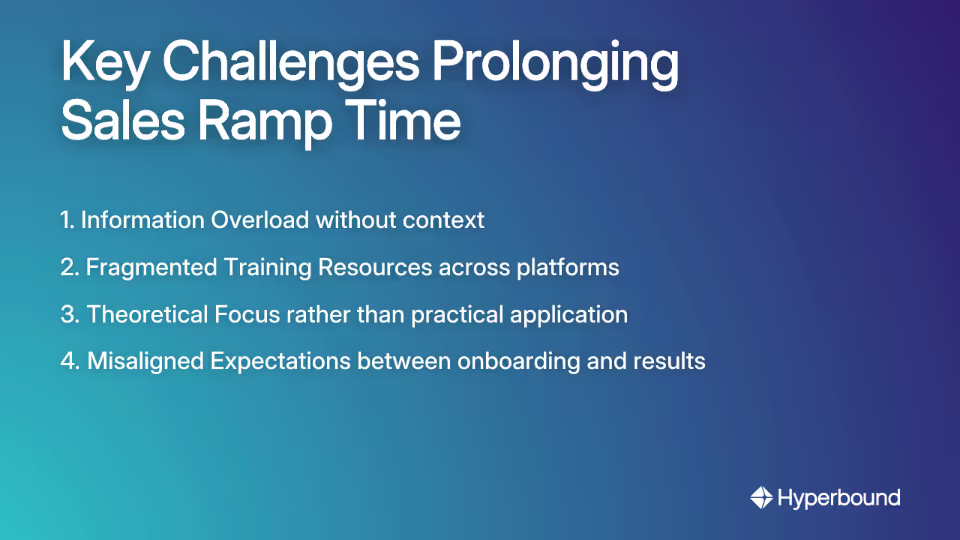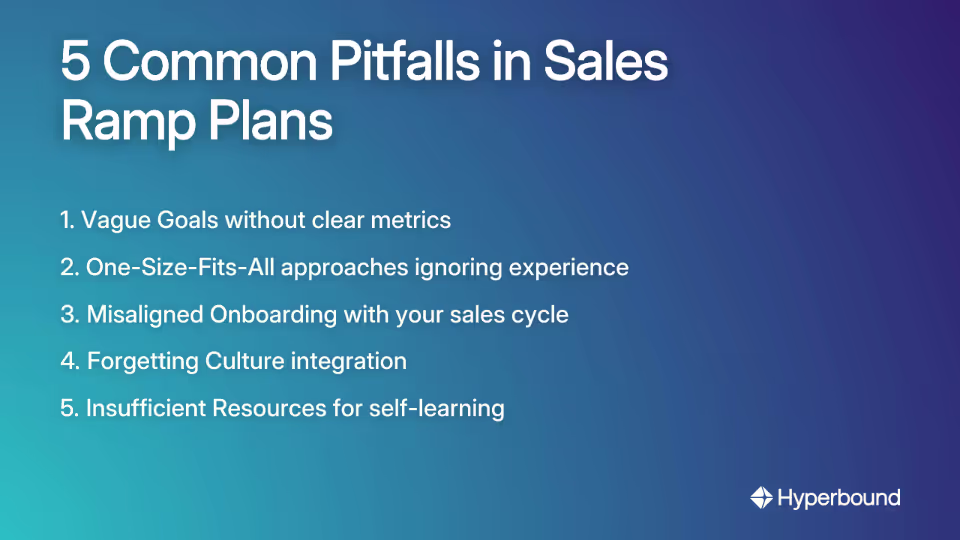.avif)
You've just hired a promising new sales rep. They're eager, talented, and ready to crush their quota. But three months later, they're struggling, frustrated, and considering their options. Sound familiar?
If you're nodding your head, you're not alone. Across sales organizations, new reps are being thrown into the deep end with "insufficient or outdated resources" and expected to "independently learn about accounts and processes" while facing "unrealistic pressure for immediate sales results."
The result? Confusion, burnout, and costly turnover that could have been prevented.
Enter the 30/60/90 day ramp plan – the strategic blueprint that transforms your onboarding chaos into quota-crushing clarity. This structured approach guides new sales hires through their critical first three months, setting clear expectations and providing the support they need to succeed.
In this ultimate guide, we'll walk you through creating an effective 30/60/90 day sales ramp plan that benefits both your organization and your new hires. Whether you're a sales leader looking to improve team performance or a new sales rep wanting to excel in your role, this comprehensive framework will help you build a foundation for long-term success.
Why Your Sales Team Can't Afford a Slow Ramp Time
Ramp time – the period it takes for a new sales hire to reach full productivity – is more than just an HR metric. It's a critical business factor that directly impacts your bottom line.
According to a 2023 study by The Bridge Group, the average sales ramp time is 3.2 months. But the breakdown reveals a concerning spread:
- 1 to 3 months (19%)
- 3 to 5 months (39%)
- 5 to 7 months (23%)
- 7+ months (18%)
That means for nearly half of organizations, new sales reps take more than five months to reach full productivity. During this extended ramp period, you're paying full compensation for partial productivity – a significant hidden cost that compounds with every new hire.
But the costs go beyond financial implications. The challenges that prolong ramp time include:

- Information Overload: New reps are bombarded with product details, competitor information, and process documentation – often without context or prioritization.
- Fragmented Training Resources: Critical knowledge is scattered across shared drives, email threads, and the institutional memory of veteran team members.
- Theoretical Focus: Traditional onboarding emphasizes knowledge transfer over practical application, leaving reps unprepared for real customer interactions.
- Misaligned Expectations: As one sales professional on Reddit noted, there's often a "discrepancy between onboarding duration and sales cycle," creating an impossible situation for new hires expected to produce results before they've experienced a full sales cycle.
The Dual-Sided Benefits of a Structured 30/60/90 Day Plan
An effective 30/60/90 day ramp plan isn't just a document – it's a strategic tool that delivers value to both the organization and the new sales rep.
For the Organization:
- Faster Ramp-Up to Productivity: By providing clear guidelines from day one, organizations help employees contribute value sooner.
- Early Identification of Gaps: Regular check-ins and milestone assessments allow managers to identify knowledge gaps or skills deficiencies and address them promptly.
- Alignment with Company Objectives: A structured plan ensures new hires understand how their role contributes to larger organizational goals.
- Assessing Fit and Potential Early: The plan provides a framework for evaluating performance and potential, allowing for informed decisions about long-term fit.
For the New Sales Rep:
- Clarity on Priorities: Instead of trying to learn everything at once, reps can focus on what's most important at each stage.
- Reduced Stress: Having a roadmap with scheduled check-ins and structured support reduces the anxiety that often accompanies a new role.
- Accelerated Learning: The plan connects reps with the right resources and training at the right time, shortening the learning curve.
- Increased Confidence and Visibility: Achieving early milestones builds momentum and confidence, while regular check-ins provide visibility with leadership.
Perhaps most importantly, a well-designed 30/60/90 day plan establishes aligned expectations for success. Both the manager and the new hire have a shared understanding of what success looks like at each stage, eliminating the guesswork and frustration that often characterize the onboarding period.
The Ultimate Guide: Building Your 30/60/90 Day Sales Ramp Plan
Now let's dive into the specific components of an effective 30/60/90 day ramp plan for sales teams. Each phase has distinct objectives that build upon the previous stage, creating a progressive journey from learning to leadership.
Phase 1: The First 30 Days – Foundation & Immersion
The first 30 days are all about learning – absorbing information, understanding the landscape, and building internal relationships. The goal during this phase is not to close deals but to build a strong foundation for future success.
Key Activities & Goals:
Company & Culture Immersion:
- Complete all HR onboarding and receive a Welcome Pack with system logins, email access, and a list of key contacts.
- Study the company's mission, vision, values, and history.
- Schedule introductory meetings with key team members across departments (marketing, customer success, product).
Product & Market Knowledge:
- Complete all required product training modules.
- Learn the ideal customer profile (ICP), buyer personas, and key value propositions.
- Review top competitor websites and marketing materials.
Process & Systems Training:
- Gain proficiency in the CRM (e.g., Salesforce, HubSpot).
- Learn the sales process, including deal stages, qualification criteria (e.g., BANT, MEDDPICC), and rules of engagement.
- Review existing content, sales collateral, and call scripts.
Learning Goals: By Day 30, the rep should be able to articulate the company's value proposition, describe the target customer, and navigate the CRM competently.
Personal Goals: Build rapport with their direct manager and at least three teammates.
Phase 2: Days 31-60 – Application & Contribution
The second 30 days mark a transition from learning to doing. During this phase, the new rep begins applying their knowledge in real-world scenarios and starts contributing to team goals.
Key Activities & Goals:
Active Engagement:
- Begin prospecting and communicating with potential customers.
- Shadow live sales calls of top performers and then begin conducting their own calls with manager supervision. As one successful sales leader on Reddit advises, "have your new reps shadow your people you know are great at certain stuff" to accelerate learning.
- Start managing a pipeline of opportunities.
Performance Goals:
- Set achievable weekly activity quotas (e.g., number of calls, emails sent, meetings booked) based on experience level.
- Goal: Achieve a certain percentage of the full ramp quota (e.g., 25-50%).
- Present analytics on past performance or conduct a territory analysis.
Skill Development:
- Participate in role-playing sessions focusing on objection handling and qualification.
- Seek feedback on call recordings from manager and peers.
- Begin developing personalized messaging and outreach strategies.
Phase 3: Days 61-90 – Autonomy & Initiative
The final 30 days focus on demonstrating mastery of the role, operating with increasing independence, and taking initiative on projects that benefit the team.
Key Activities & Goals:
Full Productivity:
- Manage the full sales cycle independently, from prospecting to closing.
- Goal: Achieve 75-100% of the standard sales quota.
- Develop a strategic plan for their assigned territory or account list.
Initiative Goals:
- Identify an area for improvement in the current sales process or playbook and propose a solution.
- Take the lead on a small project or initiative that benefits the team.
- Begin mentoring newer hires or sharing best practices in team meetings.
Advanced Skills:
- Focus on advanced sales skills training: complex negotiation, strategic account planning, and closing techniques.
- Contribute to the customer knowledge base by documenting challenges and success stories.
- Develop a personal plan for continued growth and development beyond the 90-day mark.
Modernizing Your Ramp Plan: Technology & Tools for Acceleration
Today's sales organizations have access to powerful tools that can significantly accelerate the ramp process. By incorporating these technologies into your 30/60/90 day plan, you can reduce ramp time while improving knowledge retention and skill development.
Centralized Resources
Combat the problem of "fragmented training resources" by creating a single source of truth for all sales knowledge:
- Learning Management System (LMS): Use a sales enablement platform or LMS to create tailored, structured onboarding paths that house all your training materials.
- Sales Playbooks: Organize materials to align with different stages of the sales process, making it easy for new reps to find relevant information.
- Customer Scenario Libraries: Provide real-world examples and case studies that help new reps understand common customer situations and effective responses.
Leverage AI and Conversation Intelligence
AI-powered tools can analyze sales conversations to identify patterns of top performers and provide real-time feedback:
- AI Role-Play: Use tools for scenario-based training that prepares reps for real calls without risk. This addresses the common critique that traditional onboarding lacks practical application.
- Conversation Analytics: Implement tools that automatically analyze call recordings and provide insights into areas for improvement.
- Just-in-Time Learning: Deploy systems that can suggest relevant resources based on upcoming meetings or current pipeline status.
In a compelling case study, GetAccept collaborated with Hyperbound to use AI role-play for sales training, resulting in a 50% reduction in ramp-up time, improved call quality, and more effective sales conversations. This real-world example demonstrates how technology can dramatically accelerate the onboarding process.

Measuring Success & Avoiding Common Pitfalls
For a 30/60/90 day ramp plan to be effective, it must include clear metrics for success and mechanisms for accountability.
Set SMART Goals
All goals in the plan should be Specific, Measurable, Achievable, Relevant, and Time-bound. For example:
- Instead of "Learn the CRM," specify "Complete CRM certification and successfully log 20 prospect interactions by day 30."
- Rather than "Improve sales skills," define "Conduct 10 discovery calls with manager feedback, achieving an average score of 8/10 on the call quality rubric by day 60."
Establish an Accountability Model
This directly addresses the need for "structured ramp plans with clear accountability and milestones" expressed by sales professionals on Reddit.
- Track KPIs: Use leading indicators like calls made, meetings set, pipeline created, and deal progress to proactively adjust training, not just lagging indicators like closed revenue.
- Regular Check-ins: Schedule weekly 1:1s with the manager to review progress against the plan, provide feedback, and remove roadblocks.
- Milestone Reviews: Conduct formal reviews at the 30, 60, and 90-day marks to assess progress, celebrate wins, and adjust the plan as needed.
Common Pitfalls to Avoid

Learn from the mistakes of others by avoiding these common pitfalls in your 30/60/90 day sales ramp plan:
- Vague Goals: Lack of clearly defined performance goals hinders motivation and makes it difficult to measure progress.
- One-Size-Fits-All: Failing to personalize the plan based on the rep's prior experience can lead to boredom or overwhelm.
- Misaligned Onboarding and Sales Cycle: A ramp plan that is too short compared to the average sales cycle sets reps up for failure, a key pain point identified in user research.
- Forgetting Culture: Failing to align training with company values and culture can lead to demotivated employees who struggle to fit in with the team.
- Insufficient Resources: Expecting new hires to "independently learn about accounts and processes" without adequate support leads to frustration and poor performance.
Conclusion: Building a Foundation for Long-Term Sales Success
A well-designed 30/60/90 day ramp plan is more than just an onboarding document – it's a strategic investment in your people and your business. By providing a structured framework that guides new sales hires through the critical phases of learning, contributing, and leading, you set them up for long-term success while accelerating their path to productivity.
Remember that the goal isn't just to get new reps ramped up quickly – it's to build a foundation for sustained high performance. This means balancing short-term activities with long-term skill development, and combining knowledge transfer with practical application.
By implementing the strategies outlined in this guide and leveraging modern tools and technologies, you can create a 30/60/90 day sales ramp plan that transforms your onboarding process from a potential point of failure into a competitive advantage. Your new hires will feel supported and empowered, your managers will have clear visibility into progress and performance, and your organization will benefit from faster time-to-productivity and improved retention.
The result? A winning sales team that consistently meets and exceeds its targets – starting from day one.
Frequently Asked Questions (FAQ)
What is a 30/60/90 day sales ramp plan?
A 30/60/90 day sales ramp plan is a structured onboarding document that outlines specific goals, activities, and expectations for a new sales representative during their first three months. It acts as a strategic roadmap, breaking down the overwhelming onboarding process into manageable phases: foundation and learning (first 30 days), practical application (days 31-60), and achieving autonomy (days 61-90). This ensures the new hire builds a solid base of knowledge and skills before being expected to perform at full capacity.
Why is reducing sales ramp time so critical?
Reducing sales ramp time is critical because it directly impacts revenue and profitability by getting new hires to full productivity faster. A long ramp time, which averages 3.2 months but can extend beyond five months, means you are paying a full salary for partial output. A faster ramp, facilitated by a structured plan, not only improves financial performance but also boosts new hire morale, confidence, and retention.
What are the key goals for each phase of the plan?
The key goals progress from learning to independent contribution. The first 30 days focus on foundational knowledge, days 31-60 focus on applying that knowledge, and days 61-90 focus on achieving autonomy and full productivity.
- Days 1-30 (Foundation): The rep should learn the company culture, products, ideal customer profile (ICP), and internal systems like the CRM. The goal is immersion, not sales.
- Days 31-60 (Application): The rep begins engaging with prospects, shadowing calls, and managing their initial pipeline. The goal is to start applying skills with supervision and hit early activity quotas.
- Days 61-90 (Autonomy): The rep should manage the full sales cycle independently, aim for 75-100% of their quota, and start taking initiative on team projects.
How do you measure the success of a sales ramp plan?
The success of a sales ramp plan is measured using a mix of leading and lagging indicators defined by SMART (Specific, Measurable, Achievable, Relevant, Time-bound) goals. Instead of just looking at closed revenue (a lagging indicator), you should track leading indicators like the number of calls made, meetings booked, and pipeline generated. Success is also measured through milestone reviews at 30, 60, and 90 days, assessing proficiency in areas like CRM usage, product knowledge articulation, and call quality scores.
What are common mistakes to avoid in a sales ramp plan?
The most common mistakes include setting vague goals, using a one-size-fits-all approach, misaligning the plan with the actual sales cycle, and providing insufficient resources. Failing to tailor the plan for a rep's experience level can lead to boredom or overwhelm. Similarly, if your sales cycle is six months long, expecting a rep to close deals in their first 60 days is unrealistic. Ensure the plan is supported by centralized, accessible training materials and includes cultural onboarding to avoid setting new hires up for failure.
How can AI and technology improve the sales onboarding process?
AI and technology can significantly improve sales onboarding by providing centralized resources, personalized practice, and data-driven feedback. Tools like a Learning Management System (LMS) can create a single source of truth for training materials. Most powerfully, AI role-play platforms allow new reps to practice customer conversations in a risk-free environment, building practical skills and confidence much faster than traditional shadowing, potentially reducing ramp time by up to 50%.
How long does it typically take for a new sales rep to ramp up?
The average sales ramp time is 3.2 months, according to research from The Bridge Group. However, this varies significantly, with nearly half of all organizations reporting ramp times of five months or longer. Factors that influence this duration include the complexity of the product, the length of the sales cycle, and, most importantly, the quality and structure of the onboarding and ramp plan provided to the new hire.

Book a demo with Hyperbound
.png)













